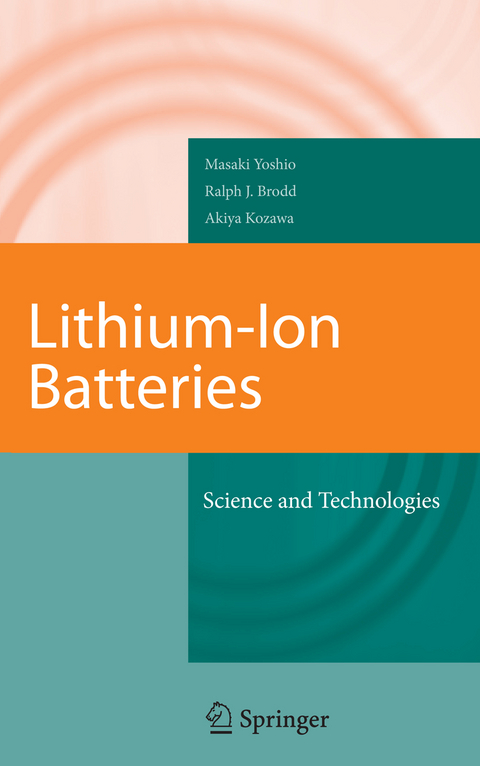
Lithium-Ion Batteries
Springer-Verlag New York Inc.
978-1-4419-2234-2 (ISBN)
My Way to Lithium-Ion Batteries Yoshio Nishi I have been engaged in research and development (R&D) on novel materials for electronic appliances for 40 years since I joined Sony Corporation in 1966. I started my scientific career in Sony as a researcher of zinc-air batteries. After 8 years in R&D on electrochemistry, my research field was shifted against my will to el- troacoustic materials, specifically diaphragm materials for electroacoustic tra- ducers including loudspeakers, headphones, and microphones. My R&D work also extended to cabinet materials for speaker systems. This about-face was uncomfo- able for me at first, but it forced me to devote myself to the investigation of various classes of materials unfamiliar to me, covering pulp and paper, metals (i. e.
, Ti, Al, Be), ceramics (B4C, TiN, BN, SiC), carbonaceous materials (carbon fibers, intr- sic carbon, artificial diamond), reinforcing fibers for FRP (carbon fibers, aromatic polyamide fibers, glass fibers, SiC fibers, superdrawn polyethylene fibers), organic polymers (polyamides, polyethylene, polypropylene, polymethylpentene, poly- ides, polysulfones, polyetherimides, polyethersulfones, PET), boards (plywood, particle board), resin composites (bulk molding compounds, resin concretes, arti- cial marble), and so on. I also was engaged in development of piezoelectric lo- speakers employing poly(vinylidene difluoride) (PVdF). The remarkably successful output from my R&D activities in those days were organic polymer whiskers and bacterial cellulose. The former was the first organic whisker in the world disc- ered by M. Iguchi,1 which is composed of polyoxymethylene (POM).
Synopsis of the Lithium-Ion Battery Markets.- A Review of Positive Electrode Materials for Lithium-Ion Batteries.- Carbon Anode Materials.- Role-Assigned Electrolytes: Additives.- Carbon-Conductive Additives for Lithium-Ion Batteries.- Applications of Polyvinylidene Fluoride-related materials for Lithium-Ion Batteries.- SBR Binder (for Negative Electrode) and ACM Binder (for Positive Electrode).- Production Processes for Fabrication of Lithium-Ion Batteries.- Polyanionic Cathode-Active Materials.- Overcharge Behavior of Metal Oxide-Coated Cathode Materials.- Development of Metal Alloy Anodes.- HEV Application.- Flame-Retardant Additives for Lithium-Ion Batteries.- High-Energy Capacitor Based on Graphite Cathode and Activated Carbon Anode.- Development of LiCoO 2 Used for Rechargeable Lithium-Ion Battery.- Cathode Materials: LiNiO2 and Related Compounds.- Manganese-Containing Cathode-Active Materials for Lithium-Ion Batteries.- Trends in Carbon Material as an Anode in Lithium-Ion Battery.- Functional Electrolytes Specially Designed for Lithium-Ion Batteries.- Lithium-Ion Battery Separators1.- Polymer Electrolyte and Polymer Battery.- A Novel Hard-Carbon Optimized to Large-Size Lithium-Ion Secondary Batteries.- LiMn2O4 as a Large-Capacity Positive Material for Lithium-Ion Batteries.
| Erscheint lt. Verlag | 13.10.2010 |
|---|---|
| Zusatzinfo | XXVI, 452 p. |
| Verlagsort | New York, NY |
| Sprache | englisch |
| Maße | 155 x 235 mm |
| Themenwelt | Naturwissenschaften ► Chemie ► Anorganische Chemie |
| Naturwissenschaften ► Chemie ► Physikalische Chemie | |
| Naturwissenschaften ► Chemie ► Technische Chemie | |
| Technik ► Elektrotechnik / Energietechnik | |
| Technik ► Umwelttechnik / Biotechnologie | |
| ISBN-10 | 1-4419-2234-2 / 1441922342 |
| ISBN-13 | 978-1-4419-2234-2 / 9781441922342 |
| Zustand | Neuware |
| Haben Sie eine Frage zum Produkt? |
aus dem Bereich


